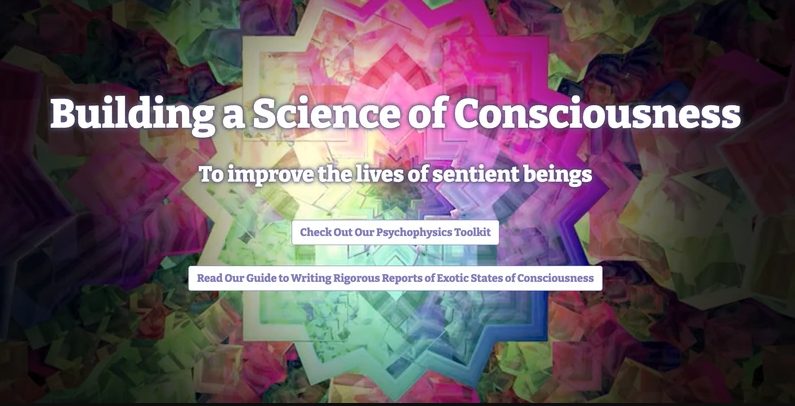Hopping goblins made of shifting shapes, clown dimensions replete with impossible jesters, and recurrent purple cosmic girlfriends—these are just some of the mysterious motifs that occur more than coincidence should allow when taking N,N-Dimethyltryptamine (DMT), the ultra-powerful psychedelic that allows users to seemingly travel to the outer reaches of the cosmos and beyond.
One of the most fascinating things about DMT is that many trips follow a specific pattern and many users experience similar realms. Amateur psychonauts—cosmic cartographers, if you will—have been “mapping” the “DMT realm” on their own for years. But an emerging branch of academic researchers—and more recently, venture capitalists and AI researchers—are now attempting to map the DMT realm using rigorous, repeatable science.
DMT hasn’t been studied all that much, but a few papers on the drug have trickled out as psychedelic research continues to gain mainstream traction. The Centre for Psychedelic Research at Imperial College London, for example, has published papers on the similarities between DMT trips and near death experiences, and found that the drug breaks down the basic networks of the brain, causing them to be less distinct from one another.
Until recently, psychonauts were limited by the brief time spent in these other worlds. Long called the “businessman’s trip” for its short duration, DMT blasts users off-world and back within 20 minutes. For the amateur psychonauts who have cataloged their time in the DMT world and sketched out their experiences in scrappily drawn maps, these temporal constraints have proved limiting. But now, an intravenous delivery system could allow people to spend more time in these bizarre zones, retrieving data about their ontology and perhaps telling us more about our waking reality.
DMT differs from other psychedelics not only in its brief duration, but in experience, too: while smaller doses feel a lot like acid, at “breakthrough” doses, it’s not only the whole field of perception that’s affected, but an entire shift in consciousness that lets the user explore bizarre, unfamiliar places.
In 2016, author Dr. Rick Strassman, along with neurobiologist and author Dr Andrew Gallimore, proposed a radical intravenous technique to administer the drug. The model could safely extend pure DMT experiences by stabilizing levels of the molecule in the blood, lengthening the trip’s peak or adjusting its power as needed. It could suspend the user in these alternate dimensions for 30-minutes, an hour or, theoretically, even longer. In science fiction, a machine such as in Katsuhiro Otomo’s Roujin Z could look after the psychonaut’s biological needs, keeping them floating in DMT space indefinitely.
“Whilst the endogenous human hallucinogen DMT reliably and reproducibly generates one of the most unusual states of consciousness available, its phenomenology has only begun to be characterized,” the paper states. “One of the reasons for this is its short duration of action. A technology for extending DMT experiences in a controlled manner beyond what is achievable using bolus administration therefore would be of great value.”
Parallel dimensions populated by machine elves that communicate in unspoken psychic languages of pure love and consciousness are interesting enough to study on their own merit. But from a “purely orthodox scientific perspective, there’s no doubt the DMT world is remarkable by itself, and worthy of deep and intense investigation,” Gallimore told Motherboard.
“These are worlds, and beings within worlds that bear no relationship whatsoever to our normal waking world—it’s far more complex, richer than our mundane conscious experience,” said Gallimore. “Many describe it as an impossible space.”
Psychedelic high strangeness notwithstanding, there are also potential medical and therapeutic benefits to the technology, says Strassman. Prolonged states could open the door to more detailed brain imaging, helping us better understand the neurocircuitry involved in the DMT experience. They could also help us find ways to optimize neurogenesis—the formation of new neurons—and neuroplasticity, the adaptive abilities of neural pathways, he says.
“Psychotherapeutically, one could, in nearly real time, increase or decrease the level of DMT intoxication by raising or lowering the infusion rate of the drug,” says Strassman. “This would allow a more or less altered state depending on the clinical needs of the patient—for example, they may want to go deeper or they want to interact and talk more.”
These experiments in DMT land may also help us understand more about our own consciousness and even the nature of ‘baseline reality.’ Rather than our three-dimensional universe, DMT seems to propel users into ‘hyper dimensional’ spaces, that is, those with more spatial dimensions than our waking world. This is remarkable, Gallimore explains, because “we can only imagine four, five, or six dimensional spaces in the abstract.” But in the DMT space, it’s as though we can actually experience them.
The Silicon Valley Connection – Exploring DMT Hyperspace
DMT is often—but not always—one of the active ingredients in ayahuasca, a plant used in ritual ceremonies by various Indigenous peoples in Latin America that has also become popular with backpackers and Silicon Valley types. One group investigating DMT space that’s attracted the attention of Silicon Valley is the Qualia Research Institute (QRI), a California-based nonprofit led by Andrés Gómez Emilsson, who has a masters in Psychology from Stanford and co-founded the Stanford Transhumanist Association in his time there. QRI describes itself as “revealing the computational properties of consciousness,” and among its donors are Silicon Valley VCs and AI and machine vision experts.
Notably, Olaf Carlson-Wee, the founder of Polychain Capital, a cryptocurrency-focused VC firm, is on the institute’s Board of Directors. Dr. Shamil Chandaria, strategic advisor at Google’s DeepMind and Wojciech Zaremba, a cofounder of OpenAI, are on its Board of Advisors.
The gist of his group, Emilsson told Motherboard, is that QRI champions a “think tank approach” for consciousness research, “where we talk to a well-educated group of highly technical and rational psychonauts, who want to understand what is going on and experiment on their own time and at their own risk.” Its broad body of work covers everything from the “music theory of consciousness” to devising web tools that chart the tracer effects of psychedelics and the “frequencies” they operate in, as well as designing protocols for phenomenological trip reports.
Delving into Qualia’s varied experiments can feel a little like a mind-bending conversation loop during a heavy trip at Burning Man: leafing through QRI’s myriad papers, the nonprofit is redolent of a heady blend of cyberpunk philosophy, psychedelic science, and abstract mathematics. But why are VCs and AI experts interested?
While Emilsson admits it’d be amusing if there was an ongoing conspiracy among machine learning experts to draw their algorithms from hallucinogenic alien universes, he believes the QRI connection is a little more mundane: that there’s simply a “very high correlation between people who are into AI and figuring out intelligence, figuring out consciousness, and how the mind works.”
But for donor Winslow Strong, speaking to Motherboard fresh from a “high-resolution, relational, resonance-based electroencephalic mirroring” session, the mysteries of consciousness are one frontier that science has struggled to conquer, and this is one of QRI’s main draws. “Our ancestors looked to the heavens and had different explanations for what stars were, but that’s largely been explained to us by physics and science,” Strong told Motherboard. “But consciousness is the most interesting mystery; science has not explained it away at all.”
Strong adds that as researchers and engineers construct artificial minds through AI, “things will get really interesting in the study of mind in general. I expect AI and the ethical ethical questions around it—is my AI conscious?—to drive foundational interests, resources, and study of the mind per se.”

Qualia Research Institute’s mission is to unearth the mysteries of consciousness with mathematical modeling, with the eventual goal of “abolishing suffering” in its entirety, perhaps even through physical devices that promote a kind of consciousness-hacking without having to imbibe heavy drugs. To do this, though, Emilsson and QRI want to establish more data points about the nature of consciousness itself.
DMT is useful for QRI’s mission, explains Emilsson, because the bizarre shapes and sights and other puzzling sensory experiences can affect us in an unusually powerful, profound way.
For instance, Emilsson believes that studying the ontology of the various DMT “heaven worlds,” which spark feelings of bliss and joy in users, could one day help us achieve a kind of “super happiness” in waking life. “There’s a bunch of heaven worlds,” Emilsson added, “[we have found] eight different varieties, and some are more blissful than others.”
In these DMT worlds, Emilsson says, there is a link between how visuals “harmonize and synchronize” and how good, or bad, they make us feel.
On the other end of the spectrum are discordant, spiky worlds that are more likely to be associated with an unnerving trip, reminiscent of the Bouba-Kiki effect, which ascribes pointy or round shapes to certain sounds—“kiki” being spiky and “bouba”
being more globular.
“There’s Kiki-and-Bouba body vibrations, there’s Kiki-and-Bouba light stimulation, and Kiki-and-Bouba DMT shapes at each of the levels of DMT,” said Emilsson. “Very unpleasant ‘life forms’ on DMT are [often] because they’re Kiki.”
DMT is extremely reliable, “like clockwork,” he says. “There’s a very consistent progression of ‘energetic life forms’ or structures you encounter, so you can absolutely systematically describe what goes on at each of the levels.”
And QRI is attempting to catalog these states: at low doses, DMT is like other psychedelics, where textures gain symmetry and morph into fractals, something Emilsson calls a “two dimensional resonant mode,” a little like a mandala wall hanging. Higher doses take users to places other psychedelics don’t: the “chrysanthemum level” sees fractals erupt and surfaces crinkle and curve in on themselves. Higher doses still rocket the user into what Emilsson calls the “crystal world,” with spiky bejeweled landscapes populated by “entire plots and energetic patterns and civilizations.”
More than that, and users experience “hyperbolic geometry,” according to Emilsson, where their entire field of perception begins to fold in on itself, a bit like heated aluminum with nowhere to expand to.
Next is what DMT voyagers call the “waiting room”—a disorienting reality completely unlike our own, sometimes decorated with chessboard patterns that hum with vibrational energy, often with a sense of some higher intelligence present, like a celestial bodyguard who decides whether or not you’ll be permitted to the final, brain-melting stage: the breakthrough experience. Breakthroughs are “really outside of people’s conceptual framework,” he says, and it’s here that the wildest trip experiences like the clown dimensions occur.
Soon, interested psychonauts may be able to explore these places for longer, and outside of a clinical setting. In Colorado, which recently voted to decriminalize psychedelic compounds, influenced by Strassman and Gallimore’s extended state project, “psychedelic specialist” Daniel McQueen founded the DMTx programme.
This grassroots DMT study group hopes to use the extended state DMT tools devised by Gallimore and Strassman to encourage the use of the drug as a problem-solving tool, McQueen told Motherboard, as well as a means for deeper exploration of peoples’ inner worlds. McQueen, who publishes training videos to help psychonauts navigate the confounding dynamics of DMT space, will eventually publish a set of instructive protocols via DMTx for making the most of these exploratory trips. The organization is currently ironing out legal kinks before it can get started, and already has gathered eight volunteers for its initial “Psychonaut Cohort” programme (one of them possibly Mike Tyson).
While Emilsson is not personally involved in the DMTx project, he believes extended experiences “make a lot of sense research-wise, and if we get the chance we definitely want to try that where legal and ethical.”
It is these extended states where baffling high-math concepts like the “hyperbolic manifold”—usually relegated to the abstract and algebraic—might actually be experienced. An extended state trip, adds the University of Greenwich’s David Luke, who has written on higher dimensional geometry, and put a stop to his personal experimentation with the drug after meeting a multi-eyed snake seraphim in the DMT realm, means we may have a better chance at determining whether the structures people experience are indeed extra dimensional, or a kind of non Euclidean geometry. Are they really dimensions we can’t ordinarily perceive, he asks, or do they only give the appearance of those places?
Charting hallucinogenic worlds and conversing with interdimensional beings is admittedly on the more esoteric end of DMT research. But Gallimore hopes that, along with the increase in university-led investigations of the molecule, more grassroots groups of researchers may form to investigate these unusual phenomena more closely, given the relative affordability of the extended-state drug.
“It’s a very different world your brain is constructing when it’s perturbed with this molecule,” Gallimore says. “Mapping DMT space is not about producing a traditional map of DMT Land, but you can start to look at structure.”
Once these initial observations are complete, researchers can start asking more questions about the relation between DMT hyperspace and our regular waking world, says Gallimore: “Is there a clear connection and a way we can describe it with Earthbound mathematics? Is it something that’s beyond our ability to formalize and mathematize? Can we test the space in some way? Can we analyze its structure? Can we get information out of the space in real time that other people can analyze, with mathematicians, linguists, anthropologists, and even artists who will be on the other side, fed this information in real time?”
We could even, Gallimore suggests, ask the all-knowing DMT jesters difficult math problems and see how they respond.
These experiments in DMT land may also help us understand more about our own consciousness and even the nature of ‘baseline reality.’ Rather than our three-dimensional universe, DMT seems to propel users into ‘hyper dimensional’ spaces, that is, those with more spatial dimensions than our waking world. This is remarkable, Gallimore explains, because “we can only imagine four, five, or six dimensional spaces in the abstract.”
These are things mathematicians, topologists, and geometers deal with, he says, but it’s impossible for us to actually comprehend what it might be like to be within a four-dimensional space: “DMT seems to allow you to say: I was in a space that had more dimensions, I was able to see all sides of an object, I saw things that were impossible.”
Our DMT: https://hallucinogenics.store/product-category/dmt/?orderby=popularity
Source: Vice News
Author: Tamlin Magee



